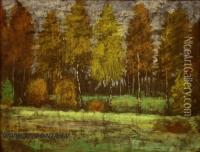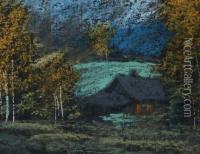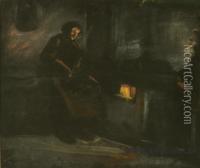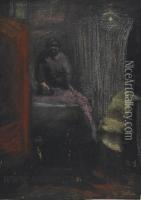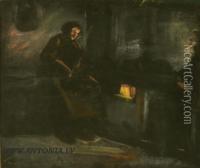Voldemars Irbe Paintings
Voldemārs Irbe was a Latvian painter and graphic artist, renowned for his contributions to the Latvian art scene during the 20th century. Born on March 20, 1904, in Riga, which at the time was part of the Russian Empire, Irbe grew up during a period of significant change and turbulence that would eventually see Latvia gain its independence in 1918.
Irbe’s artistic journey began at the Art Academy of Latvia in Riga, where he studied from 1924 to 1931. His education was complemented by studies abroad, which was a common practice among Baltic artists seeking broader influences. Irbe was particularly influenced by the modernist movements of the time, which would come to shape his style and approach to art.
Throughout his career, Irbe was known for his versatility, working in various media including painting, graphic art, and book illustration. His early works often focused on the Latvian landscape, capturing the essence of the country’s natural beauty. These works were characterized by a strong sense of nationalism and an affinity for the Latvian countryside, which he depicted with a delicate and evocative touch.
During the 1930s and 1940s, Irbe's artistic output continued to evolve. His style became increasingly abstract, though he never fully abandoned representational art. Irbe's work from this period reflects a broader trend in European art, where artists were moving away from strict representation towards more abstract and expressive forms.
The Second World War and the subsequent Soviet occupation of Latvia had a profound impact on Irbe’s life and work. Like many of his contemporaries, he faced significant challenges under the Soviet regime, which imposed strict controls on artistic expression and sought to harness art for propaganda purposes. Despite these challenges, Irbe continued to work and adapt, producing art that retained his unique perspective while navigating the constraints of the time.
Irbe’s legacy in Latvian art is significant. He was not only a prolific artist but also an influential teacher, sharing his knowledge and skills with a younger generation of Latvian artists. Throughout his career, he participated in exhibitions both in Latvia and internationally, contributing to the spread of Latvian art and culture beyond the country's borders.
Voldemārs Irbe passed away on August 21, 1997, in Riga, Latvia. His work continues to be celebrated for its contribution to the national artistic heritage and is part of the collections of major Latvian museums, as well as being valued by private collectors. Irbe's art is a testament to his enduring spirit and the rich cultural tapestry of Latvia during a century of great change.
